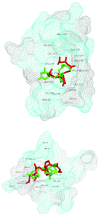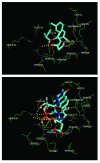Lovastatin lactone may improve irritable bowel syndrome with constipation (IBS-C) by inhibiting enzymes in the archaeal methanogenesis pathway
- PMID: 27347377
- PMCID: PMC4909102
- DOI: 10.12688/f1000research.8406.3
Lovastatin lactone may improve irritable bowel syndrome with constipation (IBS-C) by inhibiting enzymes in the archaeal methanogenesis pathway
Abstract
Methane produced by the methanoarchaeon Methanobrevibacter smithii ( M. smithii) has been linked to constipation, irritable bowel syndrome with constipation (IBS-C), and obesity. Lovastatin, which demonstrates a cholesterol-lowering effect by the inhibition of HMG-CoA reductase, may also have an anti-methanogenesis effect through direct inhibition of enzymes in the archaeal methanogenesis pathway. We conducted protein-ligand docking experiments to evaluate this possibility. Results are consistent with recent clinical findings.
Methods: F420-dependent methylenetetrahydromethanopterin dehydrogenase ( mtd), a key methanogenesis enzyme was modeled for two different methanogenic archaea: M. smithii and Methanopyrus kandleri. Once protein models were developed, ligand-binding sites were identified. Multiple ligands and their respective protonation, isomeric and tautomeric representations were docked into each site, including F420-coenzyme (natural ligand), lactone and β-hydroxyacid forms of lovastatin and simvastatin, and other co-complexed ligands found in related crystal structures.
Results: 1) Generally, for each modeled site the lactone form of the statins had more favorable site interactions compared to F420; 2) The statin lactone forms generally had the most favorable docking scores, even relative to the native template PDB ligands; and 3) The statin β-hydroxyacid forms had less favorable docking scores, typically scoring in the middle with some of the F420 tautomeric forms. Consistent with these computational results were those from a recent phase II clinical trial ( NCT02495623) with a proprietary, modified-release lovastatin-lactone (SYN-010) in patients with IBS-C, which showed a reduction in symptoms and breath methane levels, compared to placebo.
Conclusion: The lactone form of lovastatin exhibits preferential binding over the native-F420 coenzyme ligand in silico and thus could inhibit the activity of the key M. smithii methanogenesis enzyme mtd in vivo. Statin lactones may thus exert a methane-reducing effect that is distinct from cholesterol lowering activity, which requires HMGR inhibition by statin β-hydroxyacid forms.
Keywords: IBS; IBS-C; Lovastatin; homology modeling; multi-site docking.
Conflict of interest statement
Figures



Similar articles
-
Hydrogen Sulfide Producers Drive a Diarrhea-Like Phenotype and a Methane Producer Drives a Constipation-Like Phenotype in Animal Models.Dig Dis Sci. 2024 Feb;69(2):426-436. doi: 10.1007/s10620-023-08197-5. Epub 2023 Dec 7. Dig Dis Sci. 2024. PMID: 38060167 Free PMC article.
-
Development of a Modified-Release Formulation of Lovastatin Targeted to Intestinal Methanogens Implicated in Irritable Bowel Syndrome With Constipation.J Pharm Sci. 2018 Feb;107(2):662-671. doi: 10.1016/j.xphs.2017.09.028. Epub 2017 Oct 6. J Pharm Sci. 2018. PMID: 28989013
-
Review article: inhibition of methanogenic archaea by statins as a targeted management strategy for constipation and related disorders.Aliment Pharmacol Ther. 2016 Jan;43(2):197-212. doi: 10.1111/apt.13469. Epub 2015 Nov 11. Aliment Pharmacol Ther. 2016. PMID: 26559904 Free PMC article. Review.
-
Lovastatin in Aspergillus terreus: fermented rice straw extracts interferes with methane production and gene expression in Methanobrevibacter smithii.Biomed Res Int. 2013;2013:604721. doi: 10.1155/2013/604721. Epub 2013 Apr 28. Biomed Res Int. 2013. PMID: 23710454 Free PMC article.
-
Pharmacodynamics and pharmacokinetics of the HMG-CoA reductase inhibitors. Similarities and differences.Clin Pharmacokinet. 1997 May;32(5):403-25. doi: 10.2165/00003088-199732050-00005. Clin Pharmacokinet. 1997. PMID: 9160173 Review.
Cited by
-
Gender-specific association between the regular use of statins and the risk of irritable bowel syndrome: A population-based prospective cohort study.Front Pharmacol. 2023 Jan 6;13:1044542. doi: 10.3389/fphar.2022.1044542. eCollection 2022. Front Pharmacol. 2023. PMID: 36686671 Free PMC article.
-
Hydrogen Sulfide Producers Drive a Diarrhea-Like Phenotype and a Methane Producer Drives a Constipation-Like Phenotype in Animal Models.Dig Dis Sci. 2024 Feb;69(2):426-436. doi: 10.1007/s10620-023-08197-5. Epub 2023 Dec 7. Dig Dis Sci. 2024. PMID: 38060167 Free PMC article.
-
Gut Dysbiosis in Irritable Bowel Syndrome: A Narrative Review on Correlation with Disease Subtypes and Novel Therapeutic Implications.Microorganisms. 2023 Sep 22;11(10):2369. doi: 10.3390/microorganisms11102369. Microorganisms. 2023. PMID: 37894027 Free PMC article. Review.
-
Gut Microbiota-Based Therapies for Irritable Bowel Syndrome.Clin Transl Gastroenterol. 2018 Feb 15;9(2):e134. doi: 10.1038/ctg.2018.2. Clin Transl Gastroenterol. 2018. PMID: 29446765 Free PMC article.
-
Gut Non-Bacterial Microbiota: Emerging Link to Irritable Bowel Syndrome.Toxins (Basel). 2022 Aug 29;14(9):596. doi: 10.3390/toxins14090596. Toxins (Basel). 2022. PMID: 36136534 Free PMC article. Review.
References
-
- Facts About IBS. Reference Source
-
- Pimentel M, Gunsalus RP, Rao SSC, et al. : Methanogens in Human Health and Disease. Am J Gastroenterol Suppl. 2012;1(1):28–33. 10.1038/ajgsup.2012.6 - DOI
-
- Miller TL, Wolin MJ: Methanogens in human and animal intestinal Tracts. System Appl Microbiol. 1986;7(2–3):223–9. 10.1016/S0723-2020(86)80010-8 - DOI
LinkOut - more resources
Full Text Sources
Other Literature Sources
Medical
Miscellaneous

